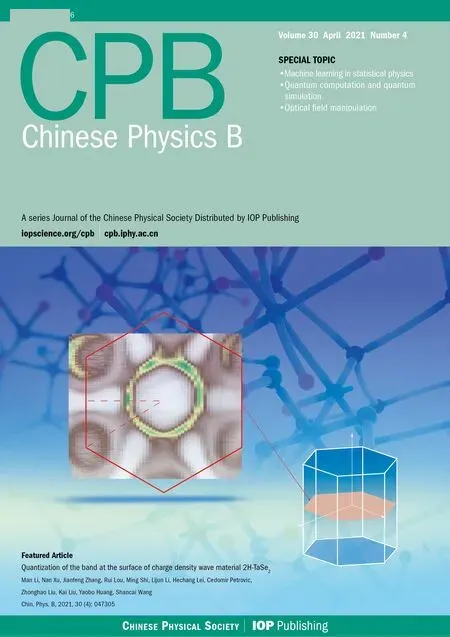Realization of adiabatic and diabatic CZ gates in superconducting qubits coupled with a tunable coupler∗
2021-05-06HuikaiXu徐晖凯WeiyangLiu刘伟洋ZhiyuanLi李志远JiaxiuHan韩佳秀JingningZhang张静宁KehuanLinghu令狐克寰YongchaoLi李永超MoChen陈墨ZhenYang杨真JunhuaWang王骏华TengMa马腾GuangmingXue薛光明YirongJin金贻荣andHaifengYu于海峰
Huikai Xu(徐晖凯), Weiyang Liu(刘伟洋), Zhiyuan Li(李志远), Jiaxiu Han(韩佳秀), Jingning Zhang(张静宁),Kehuan Linghu(令狐克寰), Yongchao Li(李永超), Mo Chen(陈墨), Zhen Yang(杨真), Junhua Wang(王骏华),Teng Ma(马腾), Guangming Xue(薛光明),‡, Yirong Jin(金贻荣),§, and Haifeng Yu(于海峰)
1Beijing Academy of Quantum Information Sciences,Beijing 100193,China
2Shenzhen Insititute for Quantum Science and Engineering,Southern University of Science and Technology,Shenzhen 518055,China
Keywords: controlled-Z gates,high fidelity gates,tunable coupler
1. Introduction

By now,the CZ gate fidelity is as high as 99.7%.[30]Fast gate and low operation errors are two keys to improve the twoqubit gates fidelity. In general,long gate time means more incoherence errors. However,shorter gate time will cause more operation errors. To solve this conflict problem, a fast adiabatic protocol is proposed[8,31,32]and the gate time is about 30–40 ns. Then, the nonadiabatic gates[33–35]are found to have fast gate time,which can eliminate the incoherent errors.
2. Experiments
In the present work,we investigate adiabatic and diabatic CZ gates in two Xmon qubits coupled with a tunable coupler system, as shown schematically in Figs. 1(a) and 1(b). Each qubit is capacitively coupled with a coupler which can be seen as an Xmon qubit. Two qubits are also directly coupled via the capacitance.The Hamiltonian of the system can be written as[24]





Fig.1. (a)and(b)The schematic electrical circuit and optical micrograph of three Xmon qubits(Q1,Q2 and C).Q1 and Q2 are used as the computational qubits with XY and Z control and coupled with the λ/4 resonators R1 and R2 for quantum state readout. Qubit C can be seen as the tunable coupler(C)with only the Z control.

Fig.2. (a) The frequency of the coupler C coupled with qubits Q1 and Q2 versus the amplitude of the bias pulse (Vb) of the coupler C. The inset is the schematic diagram. The red curves are numerical simulation results fitting the spectrum of qubit–coupler–qubit systems. Two double arrow segments indicate the anti-crossing points and the coupling strength g1c/2π = g2c/2π = 100 MHz. (b) The iSWAP oscillation when changing the amplitude Vb of the bias pulse of the coupler C. The inset is the schematic of iSWAP experiment. (c) Fourier transform of iSWAP oscillation in(b).The effective coupling strength ˜g/2π can vary from 0.40 MHz to 80 MHz. The red curve shows the calculated results with g12/2π =5 MHz.
3. Results and discussion



Fig.3. (a) and (b) Schematic of a Ramsey-type experiment measuring the conditional phase of CZ gate. Qubit Q1 is prepared in its ground or excited state.Two π/2-pulses(the second π/2-pulse has a phase shift α)are applied on qubit Q2 with an interleaved idle gate of duration τ,during which the CZ gate (an half-period cosine shape pulse) is applied on coupler C. (c) The oscillations of the population of qubit Q2 are measured by sweeping the amplitude Vb of CZ gate and the second X/2 gate phase shift α. The top and bottom figures are Q1 in its ground state and its excited state, respectively.(d)The initial phases φId and φX of the oscillation traces in(c)are fitted as a function of Vb, which are displayed by the blue and green lines, respectively. The conditional phase φc=φX −φId can be extracted as a function of Vb (yellow line). The gray criss-cross line indicates φc=π with proper Vb.


Fig.4. Fidelity and error analysis of the adiabatic CZ gate. (a)Measured sequence fidelity(100 averages)as a function of the number of Cliffords m for both the reference(diamond)and interleaved(circular)RB experiments. Error bars are the standard deviations from the mean. (b)Measured sequence purity(100 averages)as a function of the number of Cliffords m for both the reference(diamond)and interleaved(circular)PB experiments.



Fig.5. (a) The control sequence to measure leakage errors when implentmenting the diabatic CZ gates. (b) Leakage error results after CZ gates.(c)Schematic of a Ramsey-type experiment measuring the conditional phase of diabatic CZ gates. The pulse shape of diabatic CZ gates is a squareshaped pulse of duration τ =18 ns. Qubit Q1 is prepared in its ground or excited state. (d)The results of the Ramsey oscillations under Vb=0.173V and Vq=0.174V. The conditional phase φc=π. (e)The conditional phase results after CZ gates.


Fig.6. Fidelity and error analysis of the diabatic CZ gate. (a) Measured sequence fidelity(100 averages)as a function of the number of Cliffords m for both the reference (blue) and interleaved (red) RB experiments. Error bars are the standard deviations from the mean. (b)Measured sequence purity(100 averages)as a function of the number of Cliffords m for both the reference(green)and interleaved(yellow)PB experiments.
4. Conclusion
In summary, we experimentally constructed a tunablecoupled two-qubit system, and realized high fidelity CZ gate in two different schemes. The highest RB fidelities of the adiabatic and diabatic CZ gates we achieved were 99.53(8)%and 98.72(2)%, respectively. The adiabatic CZ gate defined by a cosine flux pulse on coupler required fewer calibrations compared to diabatic CZ gate, which was implemented by applying parallel square-sharped flux pulses both on coupler and one of the frequency tunable qubits. Purity benchmarking which describes incoherence error was also studied. We found that incoherence error contributed 64%and 47%in total error per Clifford gate for adiabatic or diabatic CZ gates, respectively.
猜你喜欢
杂志排行
Chinese Physics B的其它文章
- Quantum annealing for semi-supervised learning
- Taking tomographic measurements for photonic qubits 88 ns before they are created*
- First principles study of behavior of helium at Fe(110)–graphene interface∗
- Instability of single-walled carbon nanotubes conveying Jeffrey fluid∗
- Relationship between manifold smoothness and adversarial vulnerability in deep learning with local errors∗
- Weak-focused acoustic vortex generated by a focused ring array of planar transducers and its application in large-scale rotational object manipulation∗
